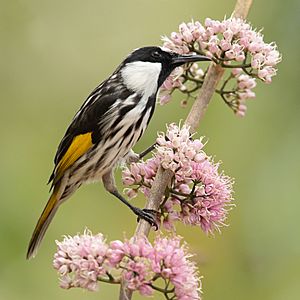White-cheeked honeyeater facts for kids
Quick facts for kids White-cheeked honeyeater |
|
|---|---|
 |
|
| Conservation status | |
| Scientific classification | |
| Genus: |
Phylidonyris
|
| Species: |
niger
|
| Synonyms | |
|
Phylidonyris nigra |
|
The white-cheeked honeyeater is a cool bird found along the east coast and in the southwest part of Australia. You can easily spot it because it has a big white patch on its cheek, dark brown eyes, and a bright yellow stripe on its wing.
Contents
Understanding the White-cheeked Honeyeater's Family Tree
The white-cheeked honeyeater was first described by a scientist named Bechstein in 1811. This is how new species get their official names!
There are two main types, or subspecies, of the white-cheeked honeyeater:
- Phylidonyris niger niger: This one lives in eastern Australia.
- P. n. gouldii: This one lives in southwest Western Australia.
The one in Western Australia looks a bit different. It has a thinner white cheek patch and more black on its chest. It also makes different sounds! Because of these differences, scientists might decide to call it a completely separate species one day.
What Does the White-cheeked Honeyeater Look Like?
This honeyeater is a medium-sized bird, mostly black and white. It has a strong bill that curves downwards, which helps it reach nectar in flowers.
Look for these features:
- Big, bright yellow patches on its tail and wings.
- A large, clear white patch on its head, right on its cheek.
- Dark brown eyes.
- A long, white line above its eye.
Younger birds have a yellow area around their mouth and a yellow line above their eye. Their feathers are also a bit duller or brownish. These birds are very active and noisy. They often fly quickly and in zig-zag patterns.
They are about 16 to 20 centimeters (6 to 8 inches) long. Males usually weigh between 15.5 and 25 grams, while females weigh 15.5 to 20 grams. That's about the weight of a few coins!
How to Tell Them Apart from Similar Birds
The New Holland honeyeater looks very much like the white-cheeked honeyeater. They are similar in size and shape. But there's one easy way to tell them apart: the New Holland honeyeater has a white eye, while the white-cheeked honeyeater has a dark brown eye.
Other black and white honeyeaters are much smaller. These include the crescent honeyeater, tawny-crowned honeyeater, and white-fronted honeyeater. Even though white-cheeked and New Holland honeyeaters look alike, they usually don't compete for food or space. They often choose different places to perch and have different times of the year when they build nests.
Where Do White-cheeked Honeyeaters Live?
The white-cheeked honeyeater is found only in Australia. It lives in two main areas:
- Eastern Australia: From Queensland, east of the Great Dividing Range, down through coastal New South Wales to Jervis Bay.
- South-western Western Australia: From Israelite Bay (east of Esperance) up to the Murchison River in Kalbarri National Park.
You can often find these birds in wet, open areas with low-growing plants, like heathlands. They also like swamps, wetlands, and forests with lots of shrubs. They live in both warm and mild climate zones. You might even see them in parks, gardens, and flowering trees in towns! They are not usually scared of people and can adapt well to living near human settlements.
White-cheeked Honeyeater Behavior
Most white-cheeked honeyeaters stay in one area. However, some might move around a bit depending on the season, especially at the edges of their living range.
What Sounds Do They Make?
The white-cheeked honeyeater has a special "chwikup, chwikup" call. They also make a pretty "chippy-choo, chippy-choo" sound. During breeding season, you might hear a higher, repeated "twee-ee-twee-ee" call when they fly around to show off.
What Do White-cheeked Honeyeaters Eat?
These honeyeaters mostly drink nectar from flowers. They love the nectar from plants like Banksia, eucalypts, Grevillea, bottlebrush, and heath. In southwest Western Australia, they also enjoy nectar from Darwinia, Calothamnus, and Dryandra plants.
Besides nectar, they also eat insects. They might pick insects off tree bark or fly out to catch them in the air. They often feed in small, busy, and noisy groups. Sometimes, they even feed right next to New Holland honeyeaters.
Reproduction and Life Cycle
White-cheeked honeyeaters usually stay with one partner during the breeding season. This can happen at any time of the year when there's plenty of nectar, but it's most common from August to November and March to May.
Male birds protect their breeding areas, sometimes for several years! They can be quite aggressive towards other birds, even other honeyeaters, during this time. But they are usually friendly with their own mates, family members, and neighbors.
The female builds a cup-shaped nest. She uses small twigs, strips of bark, and other plant bits. She holds it all together with spider webs and lines the inside with soft plant fluff and flower pieces. The nest is usually hidden low in a tree or bush, often close to the ground, among dense leaves or grass.
She lays 2 or 3 eggs. Each egg is about 21 x 15 millimeters (0.8 x 0.6 inches). The eggs are whitish-buff to pink, with reddish-brown and grey spots near the wider end. The female sits on the eggs for about 15 days to keep them warm. Both parents then feed the baby birds for another 15 days after they hatch. They continue to feed the young birds for several weeks even after they leave the nest.
Conservation Status
The white-cheeked honeyeater is listed as "least concern" on the IUCN Red List. This means that their population is stable, and they are not currently at risk of disappearing.
Gallery
See also
 In Spanish: Mielero cariblanco para niños
In Spanish: Mielero cariblanco para niños



